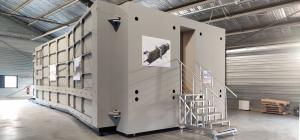A full-scale mockup for dress rehearsals
Every port in the ITER vacuum vessel has a corresponding port cell in the Tokamak Building. These corridor-like spaces allow heating and fuelling pipes, electricity cables, diagnostic lines and maintenance systems to pass through to the machine from outlying galleries. The ITER Port Plugs & Diagnostics Division is using a real-size mockup of a port cell to perform safety-related tests and to practice maintenance actions and checks for port-based diagnostic components.
Since human intervention is involved in port cell maintenance, dress rehearsals will be run to make sure equipment can be physically accessed and workers can get the job done quickly enough to minimize exposure to contaminants and radiation.
"We want to make sure we have a testbed before ITER operation," says Victor Udintsev, Section Leader in the Diagnostic Engineering Section. "But that won't be its only use. Diagnostic port plugs will have to be accessible and maintainable during the lifetime of ITER. So once operations begin, we would like to use the same dedicated mockup to practice interventions."
The first version of a simplified full-scale mockup, replicating a real port environment at ITER, has already been built at an off-site facility near ITER. The mockup is made of relatively cheap materials, including wood.
"We started to work on the mockup more than a year ago, collaborating with external companies for the design and construction of the facility in a building we rent in Corbières," says Udintsev. "The first phase of port plug mockup construction is now completed. On the scale of ITER projects, that was a quick exercise."
"We've already experimented moving in and out of the structure to check for accessibility," says Udintsev. "We practiced with a person in a bubble suit, and we also did a dry run of a visit with safety hats through the facility. These tests were not recorded or used for any proof. They were just early attempts to use the facility. Having said that, some of the early feedback has already been communicated back to engineers to improve the design of the ports."
While the full-scale mockup is already in a state where initial tests can be run, further upgrades are expected. For example, shielding and diagnostic windows will be added, and mini mockups of some of the diagnostic systems will be put inside.
While the mockup was designed primarily to carry out maneuverability tests for humans wearing bubble suits, it is fully compatible with future robotic operations. As the ITER design matures and engineers from maintenance and remote handling develop tools, the new tools may be brought into the mockup to see how they behave inside a close approximation to the real environment.
While the nature of the port cells is fundamentally the same, some of the components might be arranged differently, and some ports cells have a few unique features. To accommodate these small differences, the mockup is configurable to meet the needs of any particular port.
The mockup is made of timber around a steel frame, on which are mounted rails that can be used to withdraw bogies (a wheel-driven platform that slides on the rail). The bogies slide out of the port mockup as they will do in a real port cell.
"We constructed this to be able to be split in two," says Michael Keane, an Engineering Consultant for Diagnostics. "We will also be able to disassemble it at some stage for storage purposes because this is a lot bigger than the facility doors. We can't disassemble it completely, but enough to store it."
The near-term work is to have a complete set of very detailed equipment delivered. These mock components, which are full-sized and made of relatively cheap material, should be delivered by July 2022.
Once all the equipment is delivered, the mockup will get near daily use. Not only will diagnostics teams use it for their investigations, but maintenance will also use it to test procedures. The mockup is also likely to be used in ways that have not been thought of yet.
"So much of our work over the years has been conceptual CAD drawings," says Keane. "But now with this mockup, which is quite a substantial structure, people walk in and immediately start to think about all the things they could do with it."


